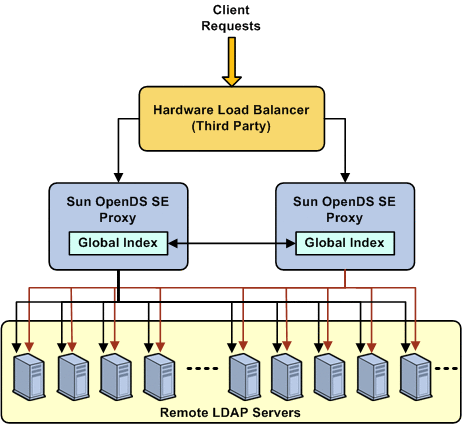| Exit Print View | |
Sun OpenDS Standard Edition 2.2 Deployment Planning Guide |

|
1. Overview of Sun OpenDS Standard Edition
2. Overview of the Directory Server
3. Overview of the Proxy Server
4. Building Blocks of the Proxy Server
5. Example Deployments Using the Directory Server
6. Example Deployments Using the Proxy Server
Deciding Your Proxy Deployment Type
Configuration 1: Simple Load Balancing
Configuration 2: Simple Distribution
Configuration 3: Failover Between Data Centers
Configuration 4: Distribution with Load Balancing
Configuration 5: Distribution with Failover Between Data Centers
7. Simple Proxy Deployments Using the Command Line Interface
To reduce the exposure of your Sun OpenDS Standard Edition proxy configuration to Single Point of Failure, you should ensure that your deployment is redundant. Typically, this can be done by installing a third party hardware load balancer, as illustrated in Figure 6-6.
Using a hardware load balancer, you can manage multiple instances of the Sun OpenDS Standard Edition proxy on separate physical machines and/or in different geographical locations.

When running multiple instances of the Sun OpenDS Standard Edition proxy, if you are using a distribution deployment with a global index catalog, the global index catalog should be replicated. For more information on replicating the global index catalog, see Replication of Global Index Catalogs in Sun OpenDS Standard Edition 2.2 Administration Guide.
In order to deploy the same Sun OpenDS Standard Edition proxy deployment see the instructions in Duplicating Your Proxy Installation in Sun OpenDS Standard Edition 2.2 Installation Guide.